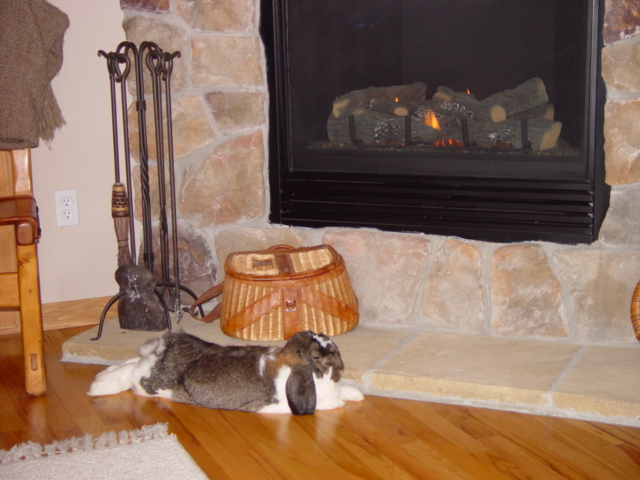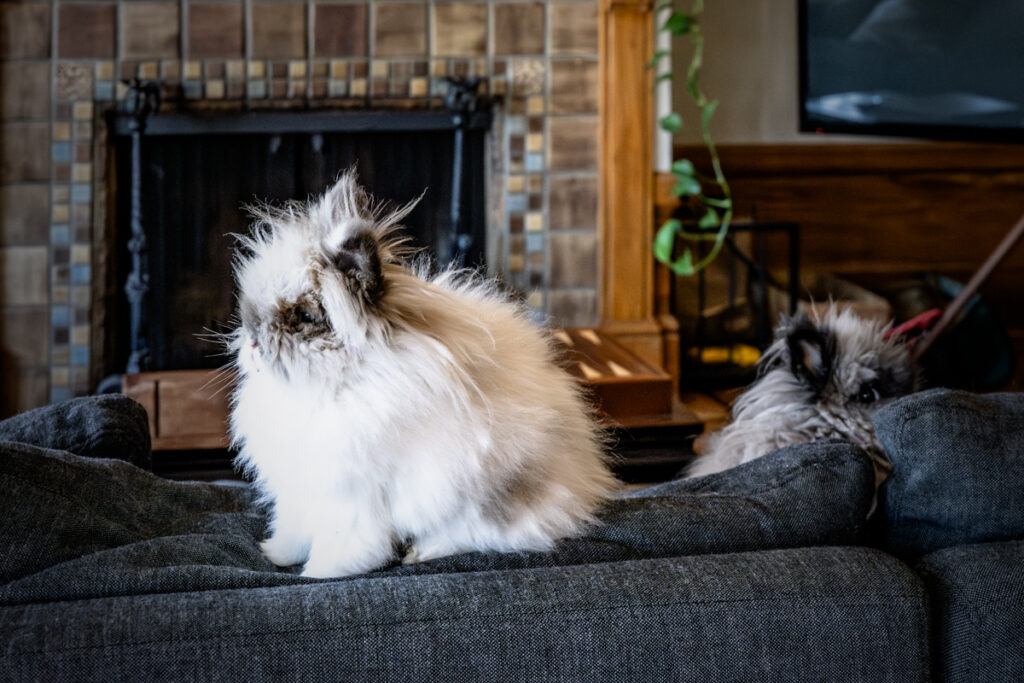As rabbits make the transition from hutch to home, some hop an easier path than others. Some are raised from the start with the freedom, safety, and privileges of a family member. More often such a status is achieved through a process of trial and error.
[Rabbit rescuers} witness this metamorphosis over and over, as homeless rabbits from various backgrounds come our way. Our work assumes that until these rabbits can be viewed as “house rabbits,” they have little chance of finding good homes. Our job as foster parents involves creating an environment where that shy or crabby or scruffy rabbit who huddled at the back of her cage at the shelter can blossom into whoever she might happen to be. The following are profiles of rabbits who made that journey with a little help from their friends.Mike the “wild” rabbit
“We have a wild rabbit,” the man tells me. “He comes to our front door for treats.”
“If he comes to your door, he’s not wild,” I reply. Feral [or even better abandoned] is the word used to describe a domesticated animal who has reverted to living away from humans. Wild rabbit species, such as cottontails, have never been domesticated. An individual wild animal may be temporarily tamed, but this is not a kindness, any more than setting a mini-lop loose in a field and expecting him to survive. For better or for worse, the domesticated animals depend on us, and the wild ones need us to leave them in peace.
Mike found himself in a cage for the first time in his life in 1988, when a population of abandoned domestic rabbits were rounded up for disposal. As Mike’s foster mom, my job was to socialize him and litterbox-train him. His litterbox was the closest thing Mike now had to a burrow, and he crouched in it, one eye peeping over the edge. It took four litterboxes, one in each corner of his cage, before Mike came up with the idea of using one for a toilet.

Can a rabbit with such a history ever be comfortable as a companion to a human? Gena Barning, who lives with Mike and his friend Elizabeth in a condominium in Glendale, California, says, “Mike enjoys the benefits of freedom, company, and a secure environment to grow old in.”
Amber the hutch rabbit
Many of us, including myself, were taught that a hutch is the correct place to keep a rabbit. Too many rabbits still live out their existence with little freedom or companionship. We now know that life in a hutch does not even provide much more safety than an open field. Every year we receive hundreds of calls from people whose rabbits died of shock while confined to a hutch, especially those kept in hutches after sundown. “I don’t understand it. When I went out this morning, the hutch was totally secure, the bunny didn’t have a mark on him, and he was dead. What happened?” The sight, scent, or sound of a raccoon, hawk, feral cat or dog can cause irrreversible and fatal shock to occur. Now that we better know our options, can a hutch rabbit make the transition to life indoors?
A chubby bunny with Siamese markings, Amber was confined to a hutch for at least a year, and perhaps all her life. Arriving at my foster home, she got a lucky break before her house-rabbit training had even started. She went home with Linda and Peter, to be a friend for their uncaged apartment rabbit, Snowshoes. Within a week, I got a call. “It’s not working,” Peter reported. “She’s destroying the carpet, ignoring the litterbox, and intimidating Snowshoes.”
I explained again Amber’s background. “This may be the first freedom she’s ever had. Even if you can’t keep her, do you think you can work with her a little?” Peter agreed to buy a cage and confine Amber some of the time. A few weeks later he called again. “Everything’s fine. We only had to confine her occasionally, and she’s much calmer now. She and Snowshoes are good friends, and we want to keep her.” Like other successful transitions, a rabbit lifestyle change is best accomplished in stages. It’s natural to want to give lots of freedom right away to an animal who has been locked up for such a long time, but freedom isn’t always what she needs at first. Cage time gave Amber the chance to get her bearings and to adjust to her new life. Now she has years and years of freedom to enjoy with her new family.
Hopscotch the stray rabbit
Incredibly, some unwanted rabbits abandoned in an urban environment or “set free” in a suburban or rural one actually survive long enough to get the attention of a passing good samaritan. Often a spontaneous rescuer knows more about the care of dogs or cats than rabbits, and turns to a rabbit person for help.
Hopscotch, a two-month-old fuzzy lop, was found in the streets by a friend of bunny person Kelly Montana. Finding that local foster homes were full, Kelly decided to make a place for Hopscotch in her apartment and to take on his rehabilitation.
Kelly found Hopscotch to be suffering multiple health problems. The rabbit digestive tract is a complex and delicate system, and she didn’t know what Hopscotch had eaten during the critical first months of his life. In addition, hardship had left him with a tenacious respiratory infection and a severe case of fur mites.
Hopscotch gained weight, grew back his coat, and finished growing up under the steady care of Kelly and the treatments prescribed by her vet. He’s become an affectionate family member- even though he had to get there the hard way. And Kelly has that very special joy that comes from adding to her household by saving a life.
Benjamin the yard rabbit
Sun, greenery, and room to romp. Some companion rabbits enjoy yard privileges as well as house-rabbit status. However, the careful rabbit guardian knows that sun can cause heat stroke, greenery can be toxic, and open spaces can be invaded by predators. Rabbits must be protected by a secondary enclosure in order to safely enjoy the great outdoors, and they must be indoors at night and in inclement weather.
What happens when a yard rabbit loses his yard? As a volunteer, I receive too many calls from people who say, “We’re moving to an apartment. We can’t keep him.” In fact, a rabbit who never goes outdoors is much luckier than one who never comes indoors. The illusion that life in the yard is “natural” and therefore good has cost many rabbits their life. Nature’s survival strategy for rabbits is harsh: reproduce a lot and die young. Eighty percent of wild rabbits don’t make it past their first year. The average lifespan for wild rabbits is two years. As a game plan for the species it works, but is it what we want for our beloved companions?
David Lang learned the hard way-by losing a rabbit-the extra care involved in allowing a rabbit outdoor playtime. When he and his wife, Helen, had to move from a house to an apartment, there was no question that Benjamin was coming along. David is sensitive to the adjustment his rabbit has had to make, and has made an effort to supply him with his former pleasures and pastimes. He made sure to bring Benjamin’s familiar toys and supplies to the new place, to help Benjamin feel at home.
You can bring the outdoors in by supplying your bunny with a large tub for digging. Fill it with shredded newspaper, straw, oat hay, dirt, or any combination. You can also plant several types of grasses (e.g., oat, rye) in a container for your bunny to nibble and forage. Cardboard boxes and mailing tubes provide burrow material. Is there a window or screen door where Thumper can observe the outdoors, sniff the breeze, and sunbathe? If no window provides instant access, you can set up a shelf that gives him an observation post. Pet-supply stores sell carpeted shelves for cats, but they work just as well for rabbits. And don’t be surprised if your outdoor bunny doesn’t miss his yard at all. The beauty and wonder of nature that we humans enjoy is due in part to our position as top-of-the-food-chain predators. For a small prey animal, the yard may look more like a place of danger than one of refuge.
What’s in a name?
House rabbit, yard rabbit, hutch rabbit-the same wonderful creature bears all these arbitrary designations. Humans create the situation and give it a name, and we have the power to change the environment and by doing so change a rabbit’s life from lonely and dangerous to safe and companionable. What could be more satisfying?

